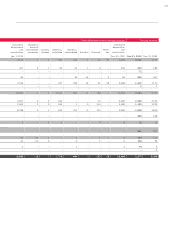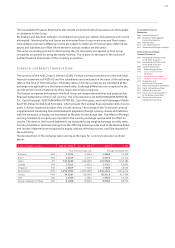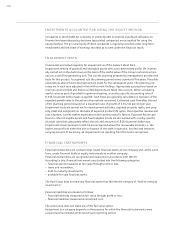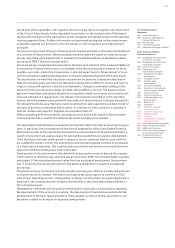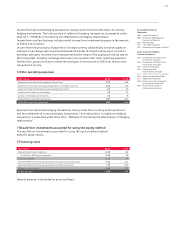Audi 2011 Annual Report Download - page 207
Download and view the complete annual report
Please find page 207 of the 2011 Audi annual report below. You can navigate through the pages in the report by either clicking on the pages listed below, or by using the keyword search tool below to find specific information within the annual report.
204
RECOGNITION AND MEASUREMENT PRINCIPLES
RECOGNITION OF INCOME AND EXPENSES
Revenue, interest income and other operating income are always recorded when the services are
rendered or the goods or products are delivered (in other words, when the risk and reward is
transferred to the customer).
Proceeds from the sale of vehicles for which buy-back agreements exist are not realized imme-
diately, but instead are realized on a straight-line basis over the period between sale and buy-back,
on the basis of the difference between the selling price and the anticipated buy-back price.
These vehicles are reported under inventories.
Operating expenses are recognized as income when the service is used or at the time they are
economically incurred.
Where additional services have been contractually agreed with the customer in addition to the
sale of a vehicle, such as warranty extensions or the completion of maintenance work over a fixed
period, the related revenues and expenses are recorded in the Income Statement in accordance
with the provisions of IAS 18 governing arrangements with multiple deliverables based on the
economic content of the individual contractual components (partial services).
Performance-based grants are recognized as income.
INTANGIBLE ASSETS
Intangible assets acquired for consideration are recognized at cost of purchase, taking into
account ancillary costs and cost reductions, and are amortized on a scheduled straight-line basis
over their useful life.
Concessions, rights and licenses relate to purchased computer software, rights of use and subsi-
dies paid.
Research costs are treated as current expenses in accordance with IAS 38. The development
expenditure for products going into series production is recognized as an intangible asset, pro-
vided that production of these products is likely to bring economic benefit to the Audi Group. If
the conditions stated in IAS 38 for capitalization are not met, the costs are expensed in the
Income Statement in the year in which they occur.
Capitalized development costs encompass all direct and indirect costs that can be directly allo-
cated to the development process. No interest was capitalized in relation to borrowing costs due
to the fact that there were no significant borrowings as defined in the criteria of IAS 23 given
that the Audi Group maintains sufficient levels of net liquidity at all times. Capitalized develop-
ment costs are amortized on a straight-line basis from the start of production over the antici-
pated model life of the developed products.
The amortization plan is based principally on the following useful lives:
Useful life
Concessions, industrial property rights and similar rights and assets 3–15 years
of which software 3 years
Capitalized development costs 5–9 years
The amortization is allocated to the corresponding functional areas.
In the case of subsidiaries that are being consolidated for the first time, the assets and liabilities
are to be measured at their fair value at the time of acquisition. These values are amortized in
the subsequent year. If the purchase price of the investment exceeds the fair value of the identi-
fied assets minus liabilities, goodwill is created.
The goodwill resulting from company acquisitions is assigned to the identifiable groups of
assets (cash flow-generating units) that are expected to benefit from the synergies created
by the acquisition.





